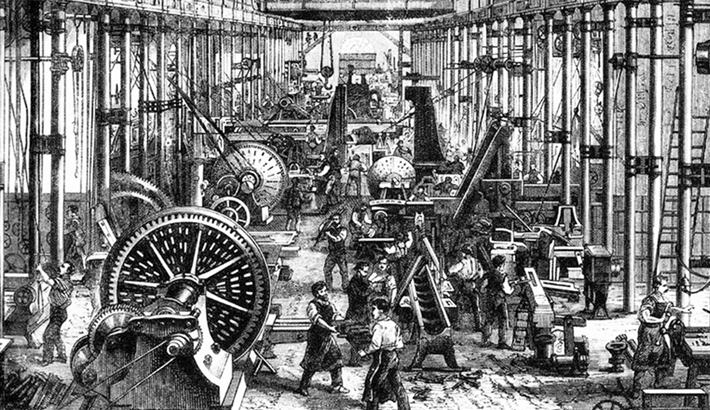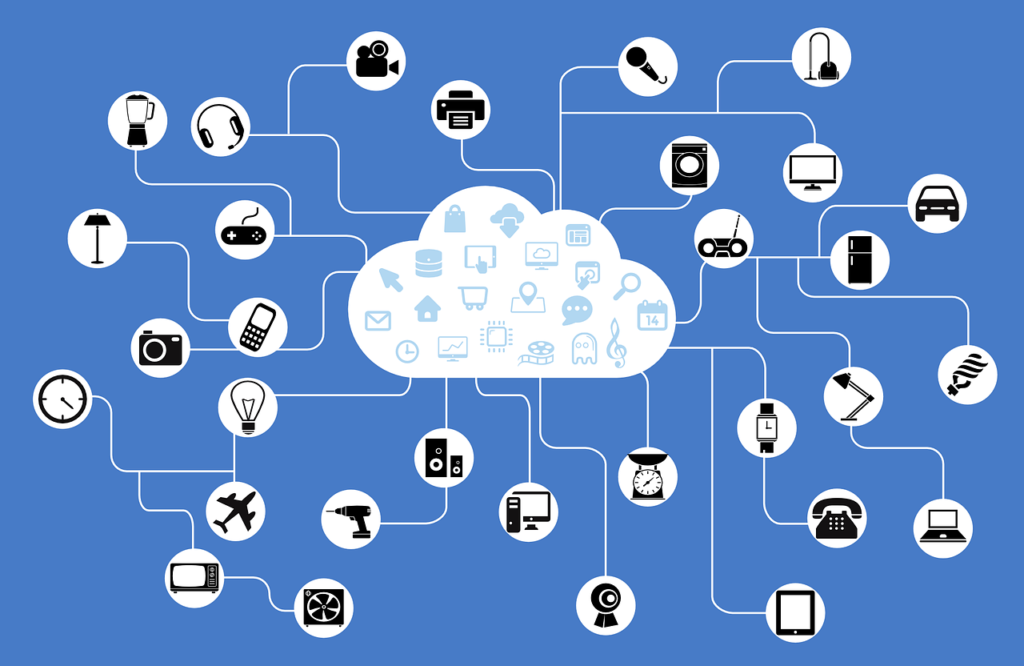Industry 4.0 is another name of The Fourth Industrial Revolution. The term “Fourth Industrial Revolution” was first coined by Klaus Schwab, CEO of World Economic Forum.
The word “revolution” refers to an abrupt and radical change in a part of human society. So the term “Industrial Revolution” refers to a radical change or transformation in the industry of the world.
From the start of the 21st century, we are living in the age of The Fourth Industrial Revolution. Human Civilization has already faced three industrial revolutions previously.
First, we will briefly explore the three previous industrial revolutions, to give you a historical context of industry 4.0. Then we will talk about how The Fourth Industrial Revolution is impacting our lives and transforming human civilization.

Historical Context of The Fourth Industrial Revolution
Revolutions have occurred throughout history when humans found new technologies and novel ways of perceiving the world. Innovations and new technologies sometimes trigger a profound change in economic systems and social structures.
The first such profound shift in human civilization was the transition from foraging to farming. It was about 10,000 years ago when the agrarian revolution happened because of the domestication of animals. Humans would no longer need to run around in the forest fighting vicious animals for food.
The First Industrial Revolution

After the agrarian revolution, the major transformation in our way of living and social structure happened around the 18th century. This is what we refer to as The First Industrial Revolution.
The industrial structure transitioned from depending on muscle power to mechanical power. The invention of the Steam Engine was the trigger that made us realize the power of machines and what they are capable of.
For the first time in our history, machines replaced humans for producing goods. This allowed us to use more of our brains and acquire practical knowledge about the world.
That is why the practice of acquiring knowledge exploded all around the world.
The Second Industrial Revolution

Historians consider the second industrial revolution to have started around the 1870s. This was a start to another transition in the manufacturing process and the world economy.
Steam engine was the icon of the first industrial revolution, and the use of electricity was the icon of the second industrial revolution.
Faraday’s discovery of the laws of electricity is the reason why we see the use of electricity everywhere in our current world.
But the implementation of electrical energy only started during the second industrial revolution.
There were other important innovations that boosted the transition of the manufacturing process during the second industrial revolution. The second industrial revolution primarily happened across Europe, the United States, and Eastern Asian countries like Japan. Then it spread across other continents and the third-world countries.
The Third Industrial Revolution

The third industrial revolution was driven by digital technologies, renewable energy, and 3D printing. It is also called the digital revolution.
Industrial revolutions have a slow start, and the start of an industrial revolution is triggered by innovations and new technologies. The icon of the third industrial revolution was the computer.
The digital revolution started its journey with the invention of a computing machine by Alan Turing.
Computers or computing machines were being used in factory production around the 1980s. That was the reason for another transformation in the manufacturing process affecting the world economy.
The Digital Revolution had a very deep impact on ICT, knowledge, health, and manufacturing processes.
Fundamental changes in the nature and location of manufacturing processes were focused on efficiencies and time delivery costs of manufacturers and distributors.
The third industrial revolution lasted until the early years of the 21st century and was the most impactful technological revolution in all of human history so far.
Characteristics of The Fourth Industrial Revolution

We are currently living at the beginning of a fourth industrial revolution. This is another technological revolution that is building on the digital revolution.
This revolution began at the turn of the 21st century. We can see the new characteristics of this revolution compared to the digital revolution-
- More omnipresent and accessible internet
- Smaller but more powerful sensors
- Artificial intelligence, which is the potential power of this revolution
- Machine Learning, implementing artificial intelligence into machines that learn and improve themselves from experience
- Digital technologies like computer hardware, software and networks are becoming more sophisticated and integrated
We are witnessing a global manufacturing system that is more interconnected than ever before. Smart factories are helping us create a world in which virtual and physical manufacturing systems flexibly cooperate with each other.
But this revolution is not simply about smart and connected machines and systems. Its scope is much wider. We are witnessing waves of simultaneous breakthroughs in areas ranging from gene sequencing to nanotechnology, from renewables to quantum computing.
The Fourth Industrial Revolution is all about the fusion of these technologies across physical, digital, and biological domains and transforming societies and the global economy.
This revolution will be every bit as powerful, impactful, and historically important if not more as the previous three revolutions.
Driving forces of The Fourth Industrial Revolution
Countless research has been done to predict which technologies will drive the fourth industrial revolution.
The scientific breakthroughs and the new technologies they generate seem limitless, unfolding on so many different fronts and in so many different places.
All of the new developments and technologies have one key feature in common: they utilize the incredible power of digitization and information technology. The following technologies are going to be the driving force behind the fourth industrial revolution:
1. Artificial Intelligence

Artificial Intelligence(AI) is undoubtedly the most important technology of the 21st century and industry 4.0. AI will have transformative impacts on far-reaching economic, legal, political, and social domains.
Artificial Intelligence (AI) can profoundly improve the efficiencies of our workplaces while amplifying the works humans can do. AI is good at matching patterns and automating processes, which makes the technology amenable to many functions in large organizations.
But there are challenges we will face when integrating AI further into our lives and giving it more control. The challenges are security issues, moral issues, etc.
Because even if AI might gain the processing power of the human brain someday, it will not gain the human feelings that are important in all walks of our lives. That is the reason we have so many researches that are being done on AI safety. We can all hope that unlike science fictions, Artificial Intelligence will not bring the end of humanity.
2. Autonomous Vehicles

When we think of autonomous vehicles, the first thing coming to our mind is a driverless car. But there are so many other autonomous vehicles including trucks, drones, aircraft, and boats
The capabilities of autonomous vehicles are improving at a high rate every day. After a few years from now, drones will be commercially available and used in regular applications.
3. 3D Printing

3D printing means the process of creating a physical object in the exact shape of a 3D drawing or a model. The traditional 2D method of manufacturing is going to be obsolete within the next decade or so.
3D printing will transform the manufacturing process in a manner that never happened before. We will see sophisticated products like car parts being produced within minutes.
You can only imagine how much faster production is going to become with the implementation of 3D printing. However, 3D printing is still too expensive a process for implementing in factory production.
After a few years, this technology will become much cheaper and we will start seeing groundbreaking implementations in the manufacturing process.
4. Internet of Things (IoT)

Internet of Things is a technology that works as a bridge between the physical systems and digital applications. The simplest explanation of this technology is- the Internet of Things is the technology that connects various physical systems and platforms by a network.
Before IoT, we would only see digital devices like smartphones and computers connected to the internet. But the Internet of things will connect many other physical things to the internet, like- clothes, buildings, transports, manufacturing machines, etc.
The Internet of things will radically change the way of our management of supply chains. We will be able to monitor and optimize assets and activities throughout their entire lifetime.
5. Blockchain Technology

Blockchain technology is sometimes also referred to as the Distributed Ledger Technology. It is a secure protocol through which a network of connected computers collectively verifies an online transaction before approving it and recording it.
This technology has revolutionized online transactions between individual persons without the need for a third party to verify the process. Nowadays, the most popular such third-party app is Paypal.
Blockchain is cryptographically secure, programmable, and a shared ledger that is not controlled by a single user, rather can be inspected by everyone. That is why blockchain is a completely trusted protocol, i.e. because of its transparency to all users.
The most popular blockchain application is Bitcoin. Bitcoin is a cryptocurrency that has no physical existence, but financial value across the entire world.
We are already seeing many similar applications like bitcoin in the world. In a few decades, blockchain will completely replace physical currency and transaction methods.
We will get a far more efficient protocol that has no geographical or government implemented boundaries.
Impact of The Fourth Industrial Revolution on The World

The fourth industrial revolution presents itself to us with many challenges alongside profound changes that can happen. If we humans fail to face these challenges successfully, then this revolution will not turn out to be a blessing like the previous ones.
The main challenges that we are facing with the fourth industrial revolution are related to changes in social structures. More specifically, Wealth Inequality and Gender Gaps.
We do not yet see any promising start to overcome these structural problems with The Fourth Industrial Revolution. The world leaders need to make radical changes in their public policies and wealth distribution policies.
Right now, 85 richest people of the world own more wealth than the bottom 3.5 billion people. This level of inequality cannot be justified by any intelligence-related arguments.
This inequality only continues to grow over time and it is high time we took necessary radical actions to face this problem. An effective solution will consist of making poor countries a part of the industrial revolution.
There is also a severe threat that is possessed by the continuous change in the climate. All of the countries need to work together to face this enormous threat.
If the current ineffective actions of the world leaders regarding climate change continue in the future, coastal countries like Bangladesh will be wiped out by natural disasters. There is no other way to face this threat without combined effort from all of the countries. This revolution has allowed the world to become more interconnected than ever before. We are on the verge of leaving physical labor entirely up to machines or robots. This will enable us to focus the abilities of our brains on acquiring more knowledge, doing more research, innovating technologies that will continue to transform the world.
Conclusion
We are not looking at a future of the world that is absolutely bright and certain. We are facing a lot of serious challenges that are questioning our further existence on earth.
If world leaders do not fight together with all the efforts to face the problems like climate change, inequality, etc. we might not have any future at all.
In conclusion, The Fourth Industrial Revolution is giving us a lot of hope for the future. But that future is not completely certain and we have to face the challenges together.
It is not the time to sit idle in the corner of the house and wait for the future, it’s the time to change the future.
Thanks for reading this article. If you have any feedback or opinion about this topic, be sure to let us know in the comment section below. I would also love to hear what other topic you want us to cover next.
Check out some of our other articles:
Historical background and impact of Industrial Revolutions
How to choose the perfect e-learning course
A leading manufacturing process in 21st century- Blow Molding Technology
Best tips for a production design manager
What is the reverse engineering technology?
3D Scanning Technology- How does it work?
The technology of offset printing





